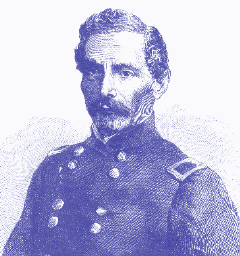|
Local Civil War History
When word was received
that Fort Sumter in Charleston, South Carolina, had been attacked by Confederate General
P. G. T. Beauregard on April 12, 1861, the call to arms by President Lincoln was issued
the next day. He sought the recruitment of 75,000 troops for a period of ninety days.
Everyone thought this would be a short war.
This would not be a neat and tidy war, with the battle lines
clearly drawn and the enemy clearly delineated. In some cases it was to be brother against
brother. President Lincoln had four brothers-in-law who fought for the Confederacy,
including one who died at the Battle of Chicamauga.
Knox Cummins was a resident of Shelby County,
Ohio, when he left for the California gold
rush in 1848. He journeyed to Central America from California a few years later, swept
up in America's desire to create a 'manifest destiny' for the rest of the world. Along
with a number of others, he was arrested for his part in an alleged insurrection. The
Americans were rescued by a warship sent by then Secretary of War Jefferson Davis. Cummins
felt he owed Davis a duty of loyalty, and therefore left his Sidney home in 1861 to fight
for the rebels. He returned home after the war and was eventually elected a Shelby County
commissioner.
Over 1,000 young men from this
county served in the Civil War. Out of the nearly thousand man 20th Ohio regiment, almost
400 enlisted from Shelby County alone. What cannot be forgotten is the impact the Civil
War had on this country. The scope of the tragedy became apparent early in the war. At the Battle of Shiloh, more Americans were killed than in all
the previous American wars combined. Ohio lost 35,000 men in the war, second only to New
York.
The local story was also
one of suffering and tragedy. Of the 18,000 county residents in 1860, over 320 did not
come home. A simple statistic will put the number of deaths in perspective. Shelby County
lost 17 men in Vietnam. As tragic as that loss was, had the population of the county been
the same then as now, 640 men would have been killed in Southeast Asia. Of the 320
soldiers from Shelby County who died in the war, two-thirds died a less than glorious
death from disease.

General P.G.T. Beauregard
'Civil War'
segment written in July, 1998 by Rich Wallace
[ Back to Civil War Index ]
|

